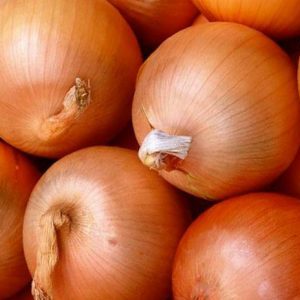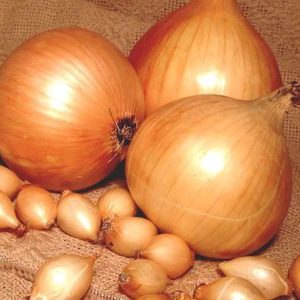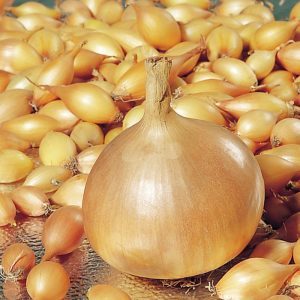Unpretentious hybrid of domestic onion "Golden Semko"
Golden Semko is a hybrid of onions created by domestic breeders. Suitable for growing both from seedlings and seedlings. Its main advantage is its high yield, regardless of weather conditions. Vegetables are almost fully ripe before harvest and stored for a long time.
The content of the article
Description
The hybrid forms round, thin-necked bulbs that retain a sharp and slightly spicy taste and useful properties for more than 7 months.

Origin and development
Golden Semko is the result of the work of domestic breeders of the Moscow company "Semko-Junior". It was added to the State Register of the Russian Federation in 2000.
Composition and useful properties
Onion Golden Semko contains:
- essential oils;
- vitamins C, PP, group B;
- phytoncides;
- potassium;
- zinc;
- iron.
The vegetable improves metabolism, has a tonic and antibacterial effect, promotes the elimination of toxins, and reduces the risk of developing cancer.
Ripening period and yield
This is an early ripe hybrid: vegetables are harvested 80–90 days after germination.
Marketable yield is on average 3.3–3.5 kg / m2.
Immunity
Although Golden Semko is resistant to common diseases and pests, due to non-observance of agricultural practices, it is affected by:
- root rot;
- fusarium;
- onion flies;
- thrips;
- caterpillars.
Specifications
The hybrid has long, about 35 cm, hollow leaves of a rich green color and single rounded bulbs. Turnips weigh 75–80 g each, covered with 2-3 golden dry scales.
The pulp is white, dense. The aroma is typical for onions, the taste is spicy.
Important! The hybrid adapts well to various climatic conditions, therefore it is grown in all regions of the country.
Main advantages and disadvantages
Advantages of the Golden Semko onion:
- high yield, regardless of weather conditions;
- amicable ripening of bulbs;
- maturation up to 99% before harvesting;
- high keeping quality: 95% of the crop lasts for 7 months;
- unpretentious care;
- resistance to drought, temperature fluctuations, diseases and pests.
Disadvantages:
- later ripening of the crop in the northern regions;
- short growing season of the ground part.
Differences from others
Comparative table of some onion hybrids:
| Hybrid | Ripening period | Productivity, kg / m2 | Bulb shape | Bulb weight, g | Taste |
| Golden Semko | Early ripe | 3,3–3,5 | Rounded | 75–80 | Acute |
| Zodiac | Late maturing | 5,9 | Rounded | 110–300 | Sweet |
| Viking | Early ripe | 5,1 | Rounded | 110–250 | Sweet |
Features of planting and growing
Golden Semko is grown from seeds in an annual culture in the southern regions, from seedlings and through seedlings in a biennial culture - in the northern and central regions.
Training
When growing seedlings, black seeds are chosen. A multi-colored shell is permissible if the seeds are treated with protective agents.
3-4 weeks before planting, about 10 seeds are taken and germinated on a napkin. If there are at least 7 germinated grains, the planting material is suitable for cultivation.
The seeds are soaked for 18 hours in water at a temperature of + 18 ... + 20 ° C, and then disinfected with a weak solution of potassium permanganate.To improve development, they are treated with growth stimulants.
Sevok is chosen dense, 1-3 cm in diameter, without rot and mechanical damage. A few days before the start of cultivation, it is dried at + 35 ... + 40 ° C, and before planting in the ground, it is soaked in a solution of copper sulfate and a growth stimulator.
Important! The necks of the bulbs are not cut so as not to interfere with the vegetation of the plants.
The site has been prepared since autumn:
- dug 20-30 cm deep;
- watered with a solution of copper sulfate for disinfection;
- after 7-10 days, 3 kg of peat, 3 kg of humus, 30 g of superphosphate, 10 g of ammonium nitrate, 15 g of potassium salt and 15 g of wood ash per 1 m2 are added;
- re-dig the ground 30 cm.
In the spring, 3-4 weeks before planting the onion, the site is dug up, 10 kg of sand, peat and 5 kg of humus are added per 1 m2. After that, the earth is carefully leveled, after breaking the clods.
Ground requirements
The hybrid develops well in light, loose and fertile soil. Avoid heavy clay soils whenever possible and prefer loams and sandstones.
Timing, scheme and landing rules
In the second half of April, when 3-4 leaves are formed on the seedlings, the seedlings dive into the beds. Sowing for seedlings is carried out at the end of February:
- Furrows are marked in a greenhouse or in containers with soil, no deeper than 2 cm, stepping back from the edge of 10 cm or leaving 5 cm between rows.
- Seeds are placed every 1.5 cm.
- Sprinkle everything with earth, slightly compact it and water it.
When growing seedlings in containers, they are covered with polyethylene and removed to a warm place with a temperature of at least + 25 ° C. After sprouting, the container is transferred to a cooler place for several days, the temperature is gradually reduced to + 10 ... + 12 ° C.
Reference! To extend daylight hours and enhance the growth of seedlings, fluorescent lamps are used.
Picking seedlings into the ground:
- The soil on the site is leveled, every 20-30 cm, furrows are dug no more than 5 cm deep.
- Seedlings and rows are watered abundantly.
- The seedlings are removed from containers, the roots are dipped in a mixture of mullein and clay. Seedlings are planted in furrows so that the distance between plants is 8–12 cm.
- Sprinkle everything with soil, tamp it a little.
- The beds are mulched with peat.
Onion sets Golden Semko are planted in spring, in early May, and in autumn, in early October. Basic condition: the soil temperature at a depth of 8–10 cm must be at least + 12 ° C.
Scheme landing sevka:
- On the plot, beds are prepared at a distance of 20-25 cm from each other.
- Dig furrows up to 5 cm deep.
- Bulbs are placed in them every 10-15 cm so that tails about 5 mm long remain above the soil surface.
Growing features

The most suitable place for the Golden Semko bow is the southern or southeastern side of the site. The place is chosen well lit and without drafts. The permissible depth of groundwater is 1–1.5 m.
The rules of crop rotation are taken into account: the hybrid is not planted after onions and garlic, the best predecessors are cucumbers, potatoes, pumpkin, zucchini, tomatoes and cabbage.
Attention! The vegetable is able to accumulate nitrates and pesticides, therefore, during active growth, dressings are used to a minimum, introducing fertilizers into the soil in advance.
The nuances of care
This is an unpretentious hybrid, the care of which consists in regular watering, feeding, loosening and weeding the soil.
Watering mode
Plants begin to irrigate after emergence. The first 2 months after planting, onions especially need moisture. Sprinkling is well suited for this. In drought, the frequency of watering is increased, with prolonged rains, it is reduced. On average, plantings are moistened once a week.
Watering is stopped 3 weeks before harvesting.
Loosening and weeding
The soil is loosened and weeded after each wetting. This will not only get rid of weeds that take nutrients from the soil, but also provide oxygen and water access to the bulbs, and prevent the development of fungal diseases.
When irrigation is stopped, the soil is loosened every 5-7 days.
Top dressing
During the growing season, onions are fertilized 1 time, 2 weeks after the emergence of sprouts. To do this, use a compost-ash infusion: 1 kg of compost and 400 g of wood ash are diluted in 10 liters of water, infused for 5 days, filtered and diluted with water in a ratio of 1: 1. Consumption - 10 liters per 1 m2.
Reference! Fresh manure is not suitable for crops: it causes an unpleasant taste in turnips.
Disease and pest control
If signs of root collar rot, fusarium or other planting diseases are detected, the soil is sprayed with a 1% solution of copper sulfate, and after 10 days it is powdered with wood ash.
To prevent damage to the culture by diseases, they observe the rules of crop rotation, irrigation regime, monitor the density of plantings, the level of humidity and temperature. After harvest, remove all plant residues.
When the appearance pests onions are treated with insecticides: "Aktellik", "Aktara" and others.
Harvesting and storage
The main signs of ripeness of vegetables are lodging of leaves and drying of the necks of the bulbs.
Turnips are harvested in the second half of July, on a clear dry day, gently pulling them out of the ground by their feathers.
Storage features and keeping quality
The harvested crop is carefully examined and sorted out, rotten and spoiled vegetables are removed. A copy with mechanical damage is set aside for the soonest use.
Onions are laid out in the sun or under a canopy for about 2 weeks to dry well. Then they are placed in nets or wooden boxes, taken out into a dark, well-ventilated room with a temperature of + 2 ... + 10 ° C.
Under the right conditions, Golden Semko can be stored for a long time: after 7 months, only 5% of the crop deteriorates.
Growing difficulties
The main problems when cultivating a hybrid:
- low yield or small turnips - the result of violation of the rules of crop rotation, planting in acidified or too heavy soil;
- premature drying and yellowing of the leaves indicates a lack of moisture;
- bulbs do not fully ripen by the time of harvest due to excessive watering and constant feeding;
- pale and thin leaves indicate a lack of nitrogen-containing fertilizers, and wilting and blackening of the tops of the foliage indicate a deficiency of fluoride.
Gardener tips
Experienced gardeners recommend:
- Divide the sevok by size: up to 5–8 mm in diameter, 8–18 mm each and up to 25 mm. Bulbs of different sizes require different care. The optimal size is 15–25 mm.
- Plant the bulbs at a medium depth so that they do not grow too elongated or deformed.
- Do not neglect the disinfection of the seed: this will reduce the risk of developing diseases.
Reviews
Reviews of the Golden Semko hybrid are mostly positive.
Vladimir, Tula: «I studied the description of many varieties and hybrids - the Golden Semko onion attracted attention, tried to plant it. I liked him for his ability to adapt to weather conditions. You can not be afraid of small fluctuations in temperature: this will not affect the harvest. Other advantages of the hybrid are high productivity and long-term storage. "
Maria, Kazan: “Our family loves onions: we eat them fresh and add them to different dishes. At the same time, I myself have not grown it myself, but a year ago the godfather shared the seedlings, and I decided to try. The debut turned out to be successful: the harvest is rich, the turnips are beautiful and strong, the culture needs minimal care. "
Conclusion
Golden Semko is an unpretentious hybrid of onions that adapts well to any climatic conditions and weather changes, suitable for growing in all regions of Russia. The culture consistently gives a high yield, with proper care it is resistant to diseases and pests. Spicy, slightly spicy bulbs are versatile in cooking, they can be stored for more than 7 months.